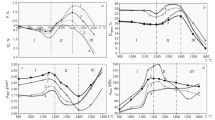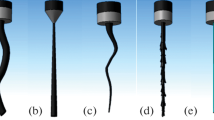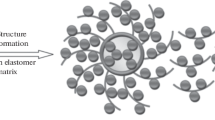Abstract
Techniques of “cold” expansion and high-temperature synthesis of high-melting inorganic compounds (carbides, borides, oxides, etc.) in the combustion wave (self-propagating high-temperature synthesis) based on chemical interactions in a condensed phase are discussed. A specific feature of these techniques is high exothermicity which provides energy to the technological needs virtually without borrowing from outside sources. The effect of physical and chemical factors on the reactions involved is analyzed. Properties of new light-weight cellular castables reinforced with protective coatings capable of sustaining temperatures up to 1400°C are reported.
Similar content being viewed by others
REFERENCES
É. A. Visloguzova, "Cooperation of metallurgists and refractory engineers – en route to success," Novye Ogneupory, No. 1, 18-21 (2002).
G. I. Gorchakov, Building Materials [in Russian], Stroiizdat, Moscow (1986).
B. A. Lur'e, B. S. Svetlov, and A. N. Chernyshev, "Aluminum: kinetics of interaction with water and aqueous alkali solutions," Kinetika Kataliz, 17, Issue 6, 1453-1458 (1976).
N. L. Glinka, General Chemistry [in Russian], Khimiya, Leningrad (1987).
I. D. Kashcheev, Production of Refractories [in Russian], Metallurgiya, Moscow (1993).
V. S. Vladimirov, I. A. Karpukhin, and S. E. Moizis, "A new generation of heat-insulating and refractory materials," Po Vsei Strane, No. 38(348), 8-11 (2002).
V. S. Vladimirov, I. A. Karpukhin, and S. E. Moizis, "New refractory and heat-insulating materials and technologies for their production," Novye Ogneupory, No. 1, 81-88 (2002).
A. G. Merzhanov, Solid Flame Combustion [in Russian], ISMAN, Chernogolovka (2000).
Chemistry of Combustion Synthesis [in Russian], Mir, Moscow (1998).
A. G. Merzhanov, Combustion and Synthesis of Materials [in Russian], ISMAN, Chernogolovka (1999).
J. B. Holt, Industrial Research and Development, 25(4), 88-91 (1983).
V. M. Shkiro and I. P. Borovinskaya, "A study into the combustion of titanium and carbon," Fiz. Goreniya Vzryva, No. 6, 945-948 (1976).
E. A. Nekrasov, Yu. M. Maksimov, A. S. Shteinberg, et al., "Capillary spreading and its effect on the propagation of combustion wave in gas-free systems," Fiz. Goreniya Vzryva, 14(5), 26-32 (1978).
V. M. Mal'tsev and G. P. Garifullina, A Report to ISMAN [in Russian], Chernogolovka (1994).
B. A. Lur'e, B. S. Svetlov, and A. N. Chernyshev, "The kinetics of dissolution of-aluminum oxide, boehmite and ?-aluminum hydroxide in alkali," Kinetika Kataliz, 17, Issue 4, 842-847 (1977).
Yu. E. Pivinskii, "Basic technology of ceramic castables," Ogneupory, No. 2, 34-42 (1978).
Yu. E. Pivinskii, Ceramic Binders and Ceramic Castables [in Russian], Metallurgiya, Moscow (1990).
Author information
Authors and Affiliations
Rights and permissions
About this article
Cite this article
Vladimirov, V.S., Karpukhin, I.A. & Moizis, S.E. Development, Technology and Physicochemical Properties of New-Generation Refractories. Refractories and Industrial Ceramics 44, 319–324 (2003). https://doi.org/10.1023/B:REFR.0000009039.14290.2a
Issue Date:
DOI: https://doi.org/10.1023/B:REFR.0000009039.14290.2a




